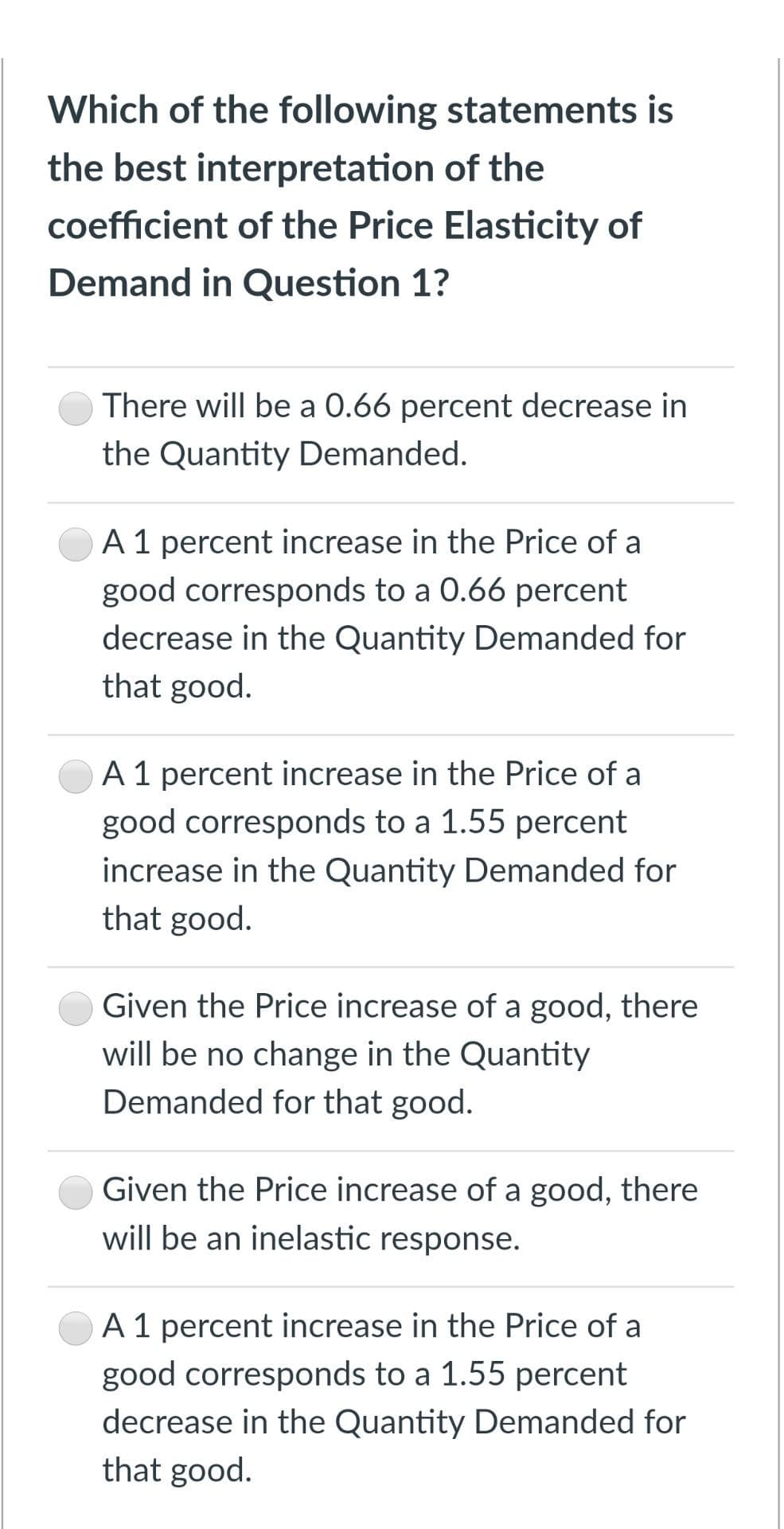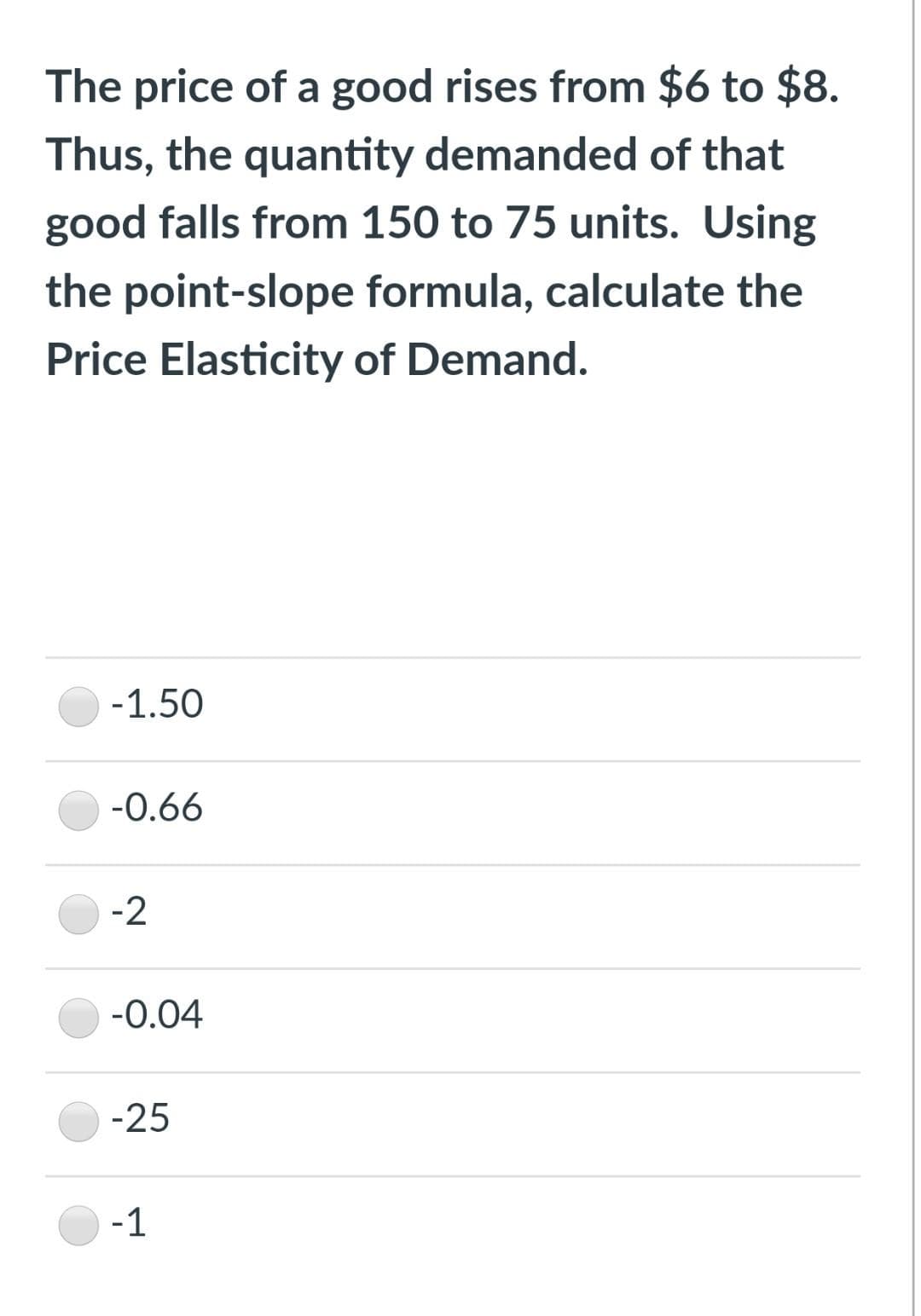Which of the following statements is the best interpretation of the coefficient of the Price Elasticity of Demand in Question 1? There will be a 0.66 percent decrease in the Quantity Demanded. A 1 percent increase in the Price of a good corresponds to a 0.66 percent decrease in the Quantity Demanded for that good. A 1 percent increase in the Price of a good corresponds to a 1.55 percent increase in the Quantity Demanded for that good. Given the Price increase of a good, there will be no change in the Quantity Demanded for that good. Given the Price increase of a good, there will be an inelastic response. A 1 percent increase in the Price of a good corresponds to a 1.55 percent decrease in the Quantity Demanded for that good.
Which of the following statements is the best interpretation of the coefficient of the Price Elasticity of Demand in Question 1? There will be a 0.66 percent decrease in the Quantity Demanded. A 1 percent increase in the Price of a good corresponds to a 0.66 percent decrease in the Quantity Demanded for that good. A 1 percent increase in the Price of a good corresponds to a 1.55 percent increase in the Quantity Demanded for that good. Given the Price increase of a good, there will be no change in the Quantity Demanded for that good. Given the Price increase of a good, there will be an inelastic response. A 1 percent increase in the Price of a good corresponds to a 1.55 percent decrease in the Quantity Demanded for that good.
Essentials of Economics (MindTap Course List)
8th Edition
ISBN:9781337091992
Author:N. Gregory Mankiw
Publisher:N. Gregory Mankiw
Chapter5: Elastic And Its Application
Section: Chapter Questions
Problem 2CQQ: The price of a good rises from 8 to 12, and the quantity demanded falls from 110 to 90 units....
Related questions
Question
Economic

Transcribed Image Text:Which of the following statements is
the best interpretation of the
coefficient of the Price Elasticity of
Demand in Question 1?
There will be a 0.66 percent decrease in
the Quantity Demanded.
A 1 percent increase in the Price of a
good corresponds to a 0.66 percent
decrease in the Quantity Demanded for
that good.
A1 percent increase in the Price of a
good corresponds to a 1.55 percent
increase in the Quantity Demanded for
that good.
Given the Price increase of a good, there
will be no change in the Quantity
Demanded for that good.
Given the Price increase of a good, there
will be an inelastic response.
A 1 percent increase in the Price of a
good corresponds to a 1.55 percent
decrease in the Quantity Demanded for
that good.

Transcribed Image Text:The price of a good rises from $6 to $8.
Thus, the quantity demanded of that
good falls from 150 to 75 units. Using
the point-slope formula, calculate the
Price Elasticity of Demand.
-1.50
-0.66
-2
-0.04
-25
-1
Expert Solution
This question has been solved!
Explore an expertly crafted, step-by-step solution for a thorough understanding of key concepts.
This is a popular solution!
Trending now
This is a popular solution!
Step by step
Solved in 3 steps

Knowledge Booster
Learn more about
Need a deep-dive on the concept behind this application? Look no further. Learn more about this topic, economics and related others by exploring similar questions and additional content below.Recommended textbooks for you

Essentials of Economics (MindTap Course List)
Economics
ISBN:
9781337091992
Author:
N. Gregory Mankiw
Publisher:
Cengage Learning

Principles of Economics 2e
Economics
ISBN:
9781947172364
Author:
Steven A. Greenlaw; David Shapiro
Publisher:
OpenStax

Managerial Economics: Applications, Strategies an…
Economics
ISBN:
9781305506381
Author:
James R. McGuigan, R. Charles Moyer, Frederick H.deB. Harris
Publisher:
Cengage Learning

Essentials of Economics (MindTap Course List)
Economics
ISBN:
9781337091992
Author:
N. Gregory Mankiw
Publisher:
Cengage Learning

Principles of Economics 2e
Economics
ISBN:
9781947172364
Author:
Steven A. Greenlaw; David Shapiro
Publisher:
OpenStax

Managerial Economics: Applications, Strategies an…
Economics
ISBN:
9781305506381
Author:
James R. McGuigan, R. Charles Moyer, Frederick H.deB. Harris
Publisher:
Cengage Learning

Exploring Economics
Economics
ISBN:
9781544336329
Author:
Robert L. Sexton
Publisher:
SAGE Publications, Inc

